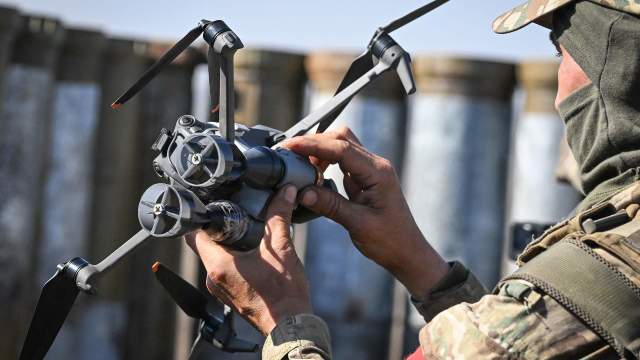The Russian industry has mastered the production of all types of drones
Currently, more than ten types of drones, from small to heavy attack ones, are in service and are actively used. Even at the beginning of the special military operation, the troops faced a shortage of them. However, in many ways this problem has been solved. President Vladimir Putin said on January 11 that domestic drones are in demand and are effectively used in their military. The Head of State stressed that our military-industrial complex needs to be ahead of the enemy in the development of unmanned aerial vehicles, since they are one of the most advanced factors of combat operations today. Izvestia looked into what developments Russia has in this area now and what their advantages are.
From the first person
The simplest and truly massive drones of a special military operation are the so-called FPV drones (First Person View—. As a rule, these are relatively small quadrocopters equipped with a camera. They are controlled by the operator in real time, and he sees the same thing as the camera, and actually controls the drone as a pilot. Such a device can carry explosives or even grenade launcher ammunition.
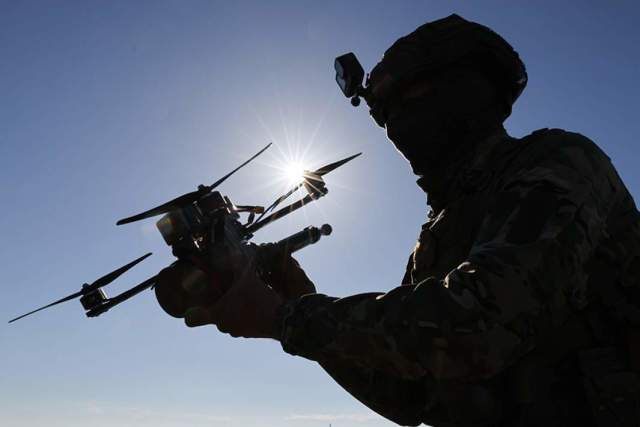
Photo: TASS/Alexey Konovalov
Image source: iz.ru
These drones can be used on infantry both in the field and in shelters. They are able to work on lightly armored vehicles or, for example, on artillery installations that do not have heavy protection. If the ammunition is powerful enough, then such a drone can damage or even destroy heavier equipment, such as a tank.
The peculiarity of these drones is that the organization of their production is certainly up to our military-industrial complex. In 2024, a new generation of FPV drones with automatic guidance systems for armored objects began to be used in a test mode in the CBO zone. The operator does not have to drive such a device before hitting the target, which means that the impact cannot be prevented by jamming systems. More efficient homing drones are, of course, more expensive, but it's worth it.
The Lancet
This type of UAV was literally the discovery of its own. The development of the Russian company ZALA was first shown to the public at the Army 2019 forum. A drone with an electric motor and an X-shaped wing is extremely in demand during operations in the tactical depth of the enemy's defense. It was on the shoulders of the Lancets that the defeat of armored objects, missile and artillery installations at a range of up to 70 km fell. Such a drone provides the ability to conduct counter-battery warfare against NATO howitzers with a firing range of up to 40 km, as well as multiple rocket launchers of the Grad type, which are used by the Armed Forces of Ukraine. The power of the warhead allows you to hit lightly armored vehicles and enemy manpower.
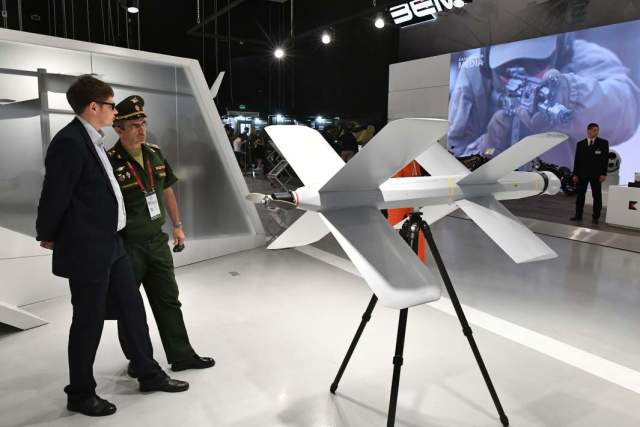
Kamikaze barrage drone "ZALA Lancet"
Image source: Photo: RIA Novosti/Mikhail Voskresensky
Today, Lancets are available in several versions and are the most popular type of kamikaze drones. They are used by hundreds of units per month and they play a huge role in revolutionary changes in the tactics of modern warfare. A lightweight model has been released, which is launched from a compact transport and launch container at a range of 20-40 km with a slightly smaller warhead.
"Cube" and "Geranium"
The first batch of kamikaze drones "Cube" with high-power combat units entered the army just before the New Year. As for the long-range kamikaze drone "Geran", they are massively used during a special military operation and it was on their shoulders that the combat work fell on the destruction of important military facilities in the rear of the Armed Forces of Ukraine, as well as the destruction of the enemy's air defense potential. It is due to the Geranium-type UAVs that an increased load is created on air defense systems, which forces the enemy to open their anti-aircraft systems and overspend missiles.
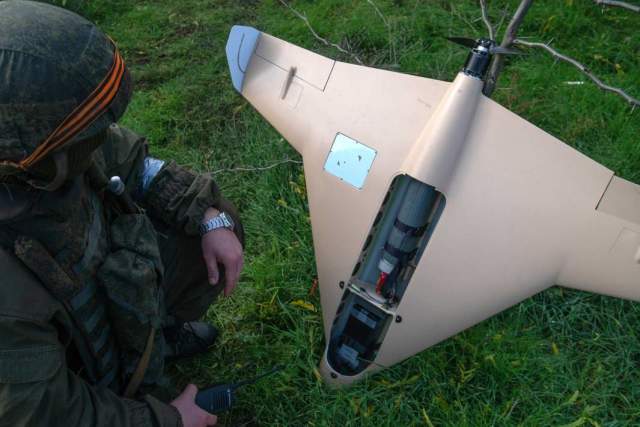
Kamikaze drone "Cube"
Image source: Photo: RIA Novosti/Ivan Rodionov
The strike capabilities of these drones also make it possible to destroy important rear facilities — buildings, warehouses, parking lots of military equipment and dual infrastructure facilities.
Intelligence services
To conduct reconnaissance directly on the battlefield, ZALA produces UAVs made according to the Z-16 flying wing aerodynamic scheme. These devices are in great demand in the area of their own defense, as they provide strike drones with information about possible targets and give completely unique opportunities to the commanders of motorized rifle and artillery units. The main task of the Z-16 is reconnaissance and fire correction at a range of up to 50-70 km, as well as monitoring the execution of strikes against enemy combat formations. Of course, it is logical to use the products of one company in a complex, and therefore the target designation of Lancetam and other devices is given by such tactical reconnaissance drones.
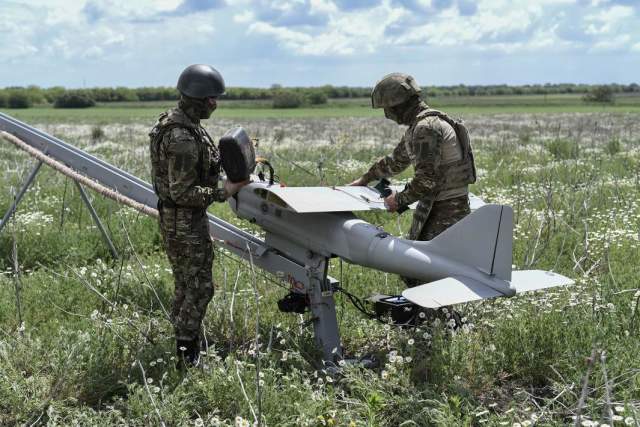
UAV "Orlan-30"
Image source: Photo: RIA Novosti/Konstantin Mikhalchevsky
Separately, it is necessary to mention one of the most in—demand reconnaissance drones for artillery and missile units - the Orlan-10 of the St. Petersburg company Special Technology Center. This is a multifunctional reconnaissance complex built around a UAV with a long flight duration (up to 16 hours), which is equipped with a piston engine and carries several variants of reconnaissance equipment. The drone can be controlled by a base station at a range of up to 120 km and, accordingly, can transmit intelligence information in real time. It is with the help of such drones that reconnaissance and strike complexes with missile complexes such as Tornado-S and Iskander-M can be formed. The Eagles can also play a role in counter-battery warfare, which has received so much attention lately.
Heavy and deadly
What about the big drones? Just the other day, the commander-in-chief of the Russian Navy, Admiral Nikolai Evmenov, announced that the Russian navy will receive heavy S-70 Hunter and Pacer (Orion) drones. Their operation requires airfields and maintenance, almost like for full-fledged aircraft. Orion has four suspension points for bombs or guided munitions and can use bombs and guided missiles against ground targets. Its range is up to 250 km, and the flight duration is up to 24 hours. By the way, it is the Orions that control the Su-34 strikes on the AFU bridgehead near Kherson.
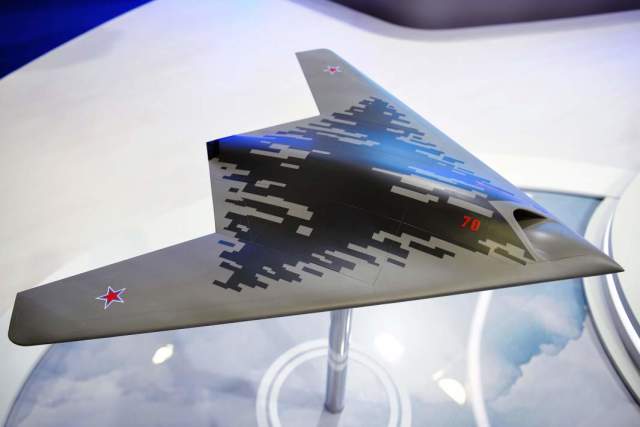
A mock-up of the S-70 Hunter unmanned aerial vehicle
Image source: Photo: RIA Novosti/Evgeny Biyatov
The large C-70 Hunter jet was developed by the Sukhoi Design Bureau and is considered the most modern stealth drone that can be used in air strike operations in conjunction with the fifth-generation Su-57 aircraft. The latter will perform the role of a leader and a target designator for the "Hunter". This will allow you not to risk an expensive manned aircraft when hacking enemy air defenses. And no other aircraft in the world has such capabilities today. Of course, this is not a battlefield combat system, but rather a strategic strike system with a range of about 6 thousand km. The length of the Hunter is 14 m, the wingspan is 19 m, and the take—off weight is more than 20 tons. And this kind of UAV may be in demand when faced with a much more serious opponent than the APU. This is a real weapon for the "war of the future", but which is already in the arsenal of the Russian aerospace forces today.
Dmitry Kornev
